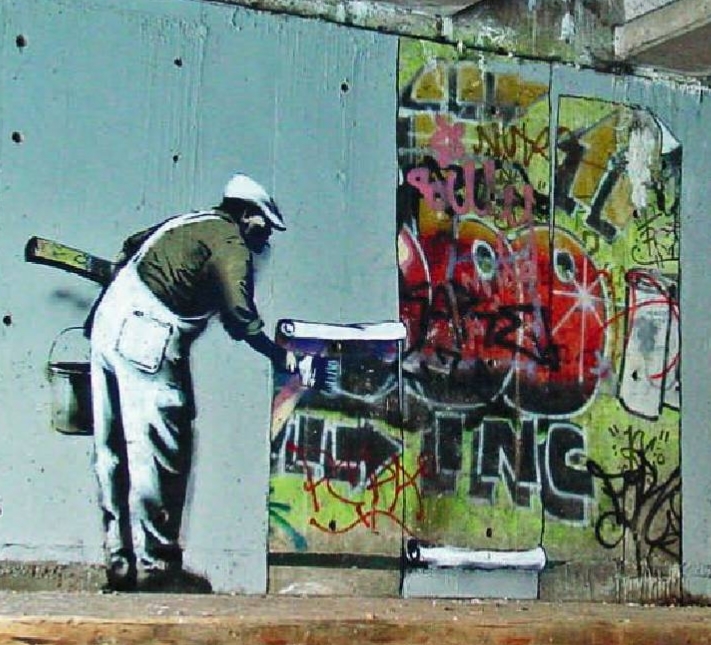Banksy and The Simpsons
To say that Banksy's couch gag opening of the Simpsons is a little critical of mass media would be a massive understatement, it drives home the ideas of mass produced culture and causes the viewer to think of the costs of the popular culture that we partake in every day.
The meaning of this opening is relatively self explanatory, the destruction of beauty and art (in the form of the unicorn) and the exploitation of other nations for the mass produced popular culture that fills our TVs and shops. The Simpsons itself is created by teams in South Korea and the knowledge of the exploitation of other nations in the creation of the first world culture industry is something well known. Not a year goes past without hearing about an incident at a factory or the conditions there, Brian Merchant's excerpt on the guardian's website (2017) being one of the prime examples of a media firestorm about such incidents. But with this being the case, why does The Simpsons, one of the most well known examples of Popular Culture feel that it is ok to talk about something they are complicit in?
The Simpsons has always been a postmodern commentary on consumer and popular culture from the very first episode. Even the earlier parts of the opening hint at consumer culture, at the ritual that most people go through every day that is only broken up by small changes and the consumption of media at the end. Wolf, Bantleon and Thoss (2011) talk about this in detail, about how the couch gag at the end (being the biggest change from episode to episode) indicate an acceptance of mass produced culture, which is also echoed in the opening with the monochrome world with the only colour being The Simpson products. This is further enforced by the references in the opening to the cartoon families that came before, the most obvious reference being to the Flintstones opening, with Fred Flintstone leaving his work in a similar (although safer) manner to Homer.
This commentary on popular culture goes further than that, within both the episodes of The Simpsons and outside of it. Dalton and Linder (2005) talk specifically about branding deals outside of the universe. Take for example the character of Krusty the Clown, traditionally in the world of the Simpsons an entertainer that is focussed on money and popularity rather than the creation of art for arts sake. His brand of cereal, Krusty-Os, had a promotion where it came with a free prize of a serrated metal O. The ridiculousness of this, driving interest in a product to the obvious detriment of its partakers, is even mimicked in the way that The Simpson marketing deals with its promotions. When Butterfinger approached The Simpsons to ask for a promotional deal the deal that they agreed to was to print pictures of Krusty with the slogan "I fully endorse this product and or service", mimicking his lack of care into the real world outside of the established Simpsons universe.
It is in this way that the Simpsons is entirely aware of the industry it belongs to, and seeks to both comment and change it from within. But how is Banksy's work similar, how does it fit into this overall picture?
First of all there are a lot of very shallow links between the two. Take for example the persona of Banksy and the world of Springfield, who Banksy is is something that is hidden from the average person, he could be a single person, he could be a team of people. In that way he is both everyone and no one. Meanwhile the town of Springfield is both everywhere and nowhere, its location is kept shrouded in mystery but at the same time it is intentionally built to be every American small town. The Simpsons is also put forward as a hollow comedy, while actually filled with commentary on culture and politics in the same way that Banksy's art is painted in back alleys and takes the form of graffiti, an art form that popular culture sees as a nuisance and meaningless while actually being very clever takes on politics, surveillance states and the consumption of media.
Banksy's work has a similar critique of mass culture to The Simpsons, take for example this particular piece:

The visual rhetorics here are clear, graffiti is art and commonly held as a form rebellion against the normative natures of culture, but it is being pasted onto the wall using mass produced wallpaper strips. The parallels between this idea and The Simpsons (with its rebellion and critique of culture being produced as a popular culture) are almost uncanny. The question of whether his creation of the opening is a push against what The Simpsons is doing or him happy to join in on the critique is almost irrelevant, as both produce the same reading for the audience.
From these readings of Banksy and The Simpsons it becomes more and more obvious that this is match made in heaven. Both parties are un-apologetic about their position inside the system, but both do what they can to change it from within, and in this way combining these efforts furthers both's goals.
References
Bull, M. (2015). This is not a photo opportunity : The street art of banksy. Chicago: PM Press.
B. (2005). POSTMODERN vANDAL. Esquire, 144(6), 198-203.
Dalton, M., & Linder, L. (2005). Sitcom reader : America viewed and skewed. Ithaca: State University of New York Press.
Storey, J. (2009). Cultural theory and popular culture : An introduction (5th ed. ed.). Harlow, England: Pearson Longman.
Wolf, W., Bantleon, K., & Thoss, J. (2011). The metareferential turn in contemporary arts and media : Forms, functions, attempts at explanation(Studies in intermediality, 5). Amsterdam: Rodopi